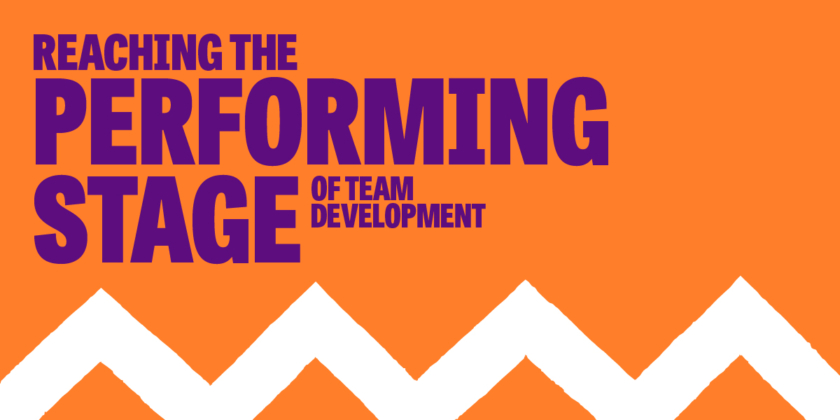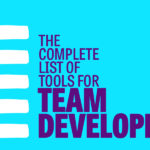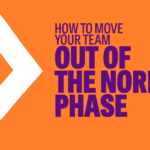How team leaders can maintain a high performance benchmark in a constantly evolving context
In the previous articles in our team development series, we’ve focused on helping managers get their teams moving through each of the stages of the team development model as quickly and efficiently as possible.
We’ve gone through how to progress from forming to storming, and then to norming, with the ultimate goal of reaching organisational utopia and getting your team to the performing stage.
But once you’re there, what’s next? Can you just say you’ve made it and chill for the foreseeable future?
Well, at Let’s Talk Talent, we think performance isn’t a static concept. Teams are made up of individuals, and none of us are capable of high performance 100% of the time. Businesses also shift and change, bringing new elements into the mix that can disturb the fragile ecosystem you’ve spent weeks, months, and sometimes years carefully curating. So, once you’ve managed to get your people to the top of the mountain, you may have to fight even harder to help them stay there.
Teams, departments and organisations ebb and flow, with each change requiring careful adjustment. So what can you do as a manager to keep that balance and give your staff the tools they need to remain focused, highly performing, and contributing to the organisation’s goals in an effective way?
We have a few tips below.
Signs your team has reached the performing stage
Before going into detail on how to keep your team in the performing zone, we thought we’d establish a baseline. After all, many will confuse norming – where everyone is working well together and even potentially reaching targets (but not quite unlocking its full potential) – with performing. How do you know the difference?
Here are some examples of a performing team:
- You are not only reaching targets, you are outperforming them;
- Individuals are spending time together and enjoying each other’s company, beyond just the work they are delivering;
- New innovative ideas are being generated and tested on a regular basis;
- Your team may be getting recognition from the wider company;
- Your skills as a leaders could also be gaining some notoriety within the organisation;
- Other people are trying to poach some of your employees.
So now you’ve ascertained you’ve made it to that elusive fourth stage of the Tuckman team development journey, how can you make sure you stay in it?
Can high performance teams last?
The first thing to mention here is that remaining at the performing stage for long periods of time cannot be done. Your organisation, your team, your staff, and you will change. This could be due, for example, to an individual leaving, new people joining, mergers, or new leadership.
People within your unit will also have ups and downs. They may be affected by personal circumstances or just be having a tough time. Each of these factors could set your team back a bit, and this is perfectly ok. Oscillating between the norming and performing phase will happen.
Being a high performing unit also comes with a growth mindset, which involves taking risks. And sometimes getting it wrong. Some tweaks to the process you were trying to improve may have made things worse, or you may have given someone new responsibilities and the fit wasn’t quite right.
Whatever has caused your staff to momentarily step out of the performance zone – fear not. Your team will have developed essential skills during their journey together and they will have gotten much better at resolving conflict and moving forward.
A few setbacks are no reason to panic. In which case, you might be wondering what your role is. After all, things are practically running themselves without the need for you to always be involved. Whilst it’s true that team leaders are still key, at this stage the responsibility of maintaining a high performance threshold now sits with the entire unit.
Don’t worry, there’s still plenty of work left to do. It’s just about shifting your priorities a bit, from initially trying to improve team dynamics to focusing on the individuals within it.
Here’s why.
Tip 1: Focusing on individual development rather than team dynamics
Now that things are running fairly smoothly in the background, it’s important to make time for personal development, which may have been slightly left aside during some of the more demanding stages of your team’s journey.
Now that other priorities have been dealt with, it’s time to think long-term and get back to developing your people’s skills, talent, and networks. This is the only way to foster the kind of growth mindset that will generate motivation, energy, and ultimately innovation.
Make sure you sit down with each person regularly to have quality career discussions. Get them to map out their strengths and weaknesses, and help them identify suitable development opportunities within your organisation.
Continuously pushing your people forward and giving them the tools they need to fully unlock their potential can only increase the contribution they make towards the wider business objectives.
Tip 2: Setting the goalposts
The line between norming and performing is fluid, and it’s easy to get complacent when things are going relatively well.
In order to keep everyone in the performing zone, team leaders need to get their staff focused and galvanised around a common goal. Your team’s purpose will need to be strong, engaging, and meaningful in order to get everyone behind it.
So, start by defining what performance means for your team. Is it about discovering new ways to do things? Or improving current processes? Do you want to focus on the quality of your deliverables?
We all know it’s impossible to be great at everything. So, if your wishlist is too long, make sure you pick the top 5 things you should really excel at as a unit and attack those with all your might.
And remember, goals should be slightly stretching. Reaching the same old benchmarks over and over may be OK for some teams, but it is not quite our definition of performance. By focussing on growth and constantly finding new challenges to overcome, your team will thrive and feel energised rather than settling into a routine.
Once everyone is clear on what needs to be done, communication will play a crucial part in engaging people and keeping them focused and aligned. Performing teams will be actively listening to each other, constructively challenging the work; so make sure you establish good, solid communication lines to keep everyone aligned and in the loop.
Tip 3: Keeping the right balance
Whilst we whole-heartedly agree that challenging the status quo is essential in order for innovation to take place, organisations sometimes expect their staff to move at a pace that isn’t sustainable. Setting stretching goals is of course great, but constantly moving the goalposts and expecting higher outputs can have a negative impact.
Think of it as an elastic band. A bit of stretch is fine, but too much pull can break it. It’s a hard line to walk and it can be tricky to quantify how much to push your people and when to let them catch their breath. The key is to think of stretching your team as a daily practice, rather than a big once-a-year formal process.
Make sure you regularly spot opportunities to develop individuals’ skills, and keep checking in with them. That way, you’ll be able to keep an ear to the ground and adapt as needed should they start to feel overwhelmed.
Balance should also extent beyond work. Adopting a human-centric approach to management will help you keep the team running well, today and in the future. So take care of your people in a holistic way, from enforcing regular breaks and promoting using holiday allowances, to giving them the tools to achieve a healthy work-life balance.
This could be done by checking they are not expected to work beyond usual business hours, or that meetings aren’t set during morning school runs. You may have to act as guardian of the flow here to protect your team’s focus and ensure they are able to work without distractions; for example, by flagging unnecessary meetings or processes and reducing red tape.
Conclusion
Staying in the performing zone may sound like a bit of a battle for a team leader. But once you’re there, think of it as a series of small adjustments that will allow you to adapt to whatever change comes your way.
At Let’s Talk Talent, we think performing is about making little tweaks everyday to continually optimise processes and outputs in an agile way, rather than grand initiatives that come along once a year.
It’s also about taking care of your people and looking after their wellbeing as human beings, both at work and outside, as they go through the ups and downs of remaining performant. We like to think of it as servant-leadership; helping your team as and when they need you, and keeping them engaged and motivated.
And, if you’ve made it to the performing stage of team management, don’t forget to celebrate! Those small milestones matter, so take a moment to pat yourself and your team on the back before going back to helping them stay at the top of their game.
If you’d like some advice on how to become a highly performant unit, have a look at our King’s College London case study for a few ideas on how to get your team to connect and work well together. Or check out our Team Development Bootcamp, designed to give you the tools and techniques to help you build a high performing and resilient team.




